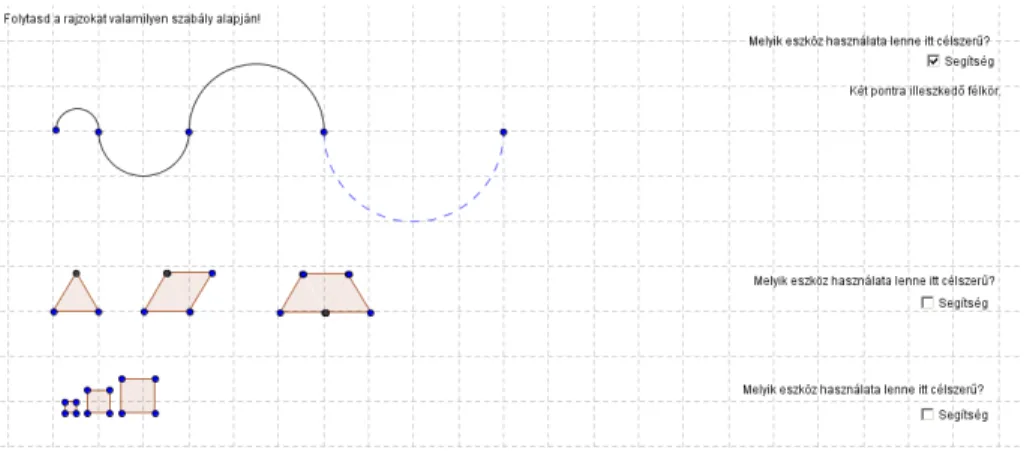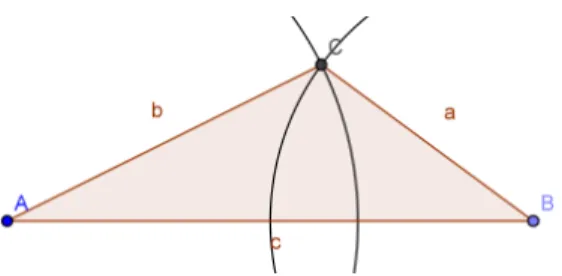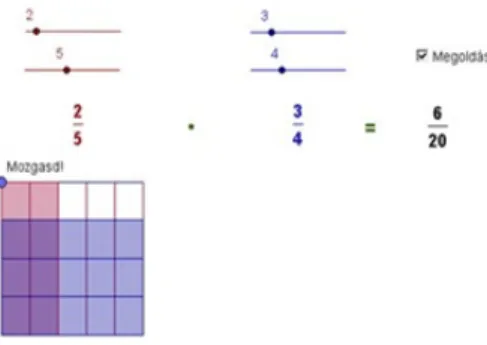38(2011) pp. 129–136
http://ami.ektf.hu
GeoGebra in fifth grade elementary mathematics at rural schools
László Budai
University of Debrecen e-mail: urlbudai0912@gmail.com
Submitted April 19, 2011 Accepted December 21, 2011
Abstract
In the fifth grade math of elementary school demonstration, representa- tion, and experimentation are of central importance. This can be achieved by dynamic softwares such as GeoGebra. The pivotal point, however, the timetable and the time to learn the management of the interface, navigation tools. It takes a couple of lessons, but in any case, the future prospects for this loss of time. It is also important to keep in mind that, in the case of top- ics that should be included in the GeoGebra, and on a what kind of manner.
Here are the results I will describe in the light of the past 3 years.
Keywords:GeoGebra, ICT in mathematics
1. Introduction
According to George Pólya [1], the mathematics teacher must be a good trader: it is necessary to sale the goods to the customer at all costs, means the mathematics to the students. This can be possible by means of motivation. The motivation is one of the basic principles of didactic methods.
The mathematics teaching sustained intellectual work, which is essential to ensure the proper motivation. It is possible to select tasks that carry the possibility of interest and awareness. It is not only necessary to develop the motivation, but to strengthen it with a planned, determinate development. The inclusion of dynamic software in the learning-teaching process, with the assistance of interactive table, where possible, apparently can create a great motivational base in those schools, where it is difficult to motivate students.
There are several dynamic softwares, but in our experience, the following points have to be taken into account at he choice by the educational institution: if the
129
program is available free of charge, i.e. to be accessible to all, Hungarian-language, cross-platform, easy-to-use, detailed help and available sample programs. GeoGe- bra [2] is a good and popular choice from this viewpoint.
The Hungarian-language Wiki GeoGebra [5] can provide worksheets, and the palette is very broad: those who want to deal with this issue, can found various samples and lots of information.
According to international research [3, 4] GeoGebra (more precisely dynamic geometry softwares) are the only tool, by which a higher (over 10%) improvement can be achieved in geometry teaching. Similar results of the relevance of GeoGebra have been found in Luxembourg [6, 7], Germany [8] and France [9] in a relatively longer term (3–5 year) within the framework of research projects, specifically at primary school age group.
The aim of this paper is to show the results of a longitudinal research in a rural school, where the effectiveness of GeoGebra-based teaching is proved with the help of a control group with classical teaching methods, even in the case of highly disadvantaged students.
2. The research environment
The school of our experimental research is a rural primary school in a small vil- lage, 80% of the students are from minorities, and 68% of the students are highly disadvantaged. The computer is already essentially a kind of motivation for these students. The tests are controlled design, the lineage system were performed: the class 5/a has been involved in the GeoGebra teaching-learning process, while the class 5/b (control group) has been performed by classical tools. At the beginning of the school years on the basis of input from the measurements in parallel classes students’ performance were nearly the same in all cases. The following table shows the results:
year 2008/2009 year 2009/2010 year 2010/2011
5/a 2,61 2,77 2,57
5/b 2,57 2,63 2,72
Table 1: Input measurements in math before application of Geo- Gebra
In the following section some thematic fields of mathematics will be discussed were GeoGebra has been proved to be extremely useful.
3. Topics and results
The following subjects have been successfully improved by GeoGebra:
1. introduction to geometry
2. geometric drawings 3. geometric transformations
4. Completion of four basic operations by integers or fractions.
3.1. Introduction to geometry
After the introduction of basic geometric concepts and grouping (shapes, flat, space, etc.), the teaching-learning process has been performed in the computer room in class 5/a. At this point 2-3 hours should have been devoted to the learning of the basics of GeoGebra software (the basic structure, interface options, points, lines, polygons, add sections, add zoom options, etc.). The first relevant GeoGebra program was as follows: a straight line through two points to add, and then locate the “end” of the line. GeoGebra worksheet is rather large, so the kids will eventually get bored of searching the straight “ends” of the line. In our experience this short practice is a very successful tool to introduce the concept of the infinity.
In the 5. grade textbook the concept of congruence is appeared in relation to the same shape and size of shapes. Many of the problems in the case of my students arise as to determine if the given shapes are congruent or not. In the GeoGebra it is possible to create an interactive, dynamic worksheet, which helps the children in the recognition process: the combination of congruent shapes (Figure 1).
Figure 1: Determine the congruent shapes
Here the children turn on the automatic solution-control (which is a check box, and are good solutions for linking), can filter out the “disturbing” factors: the color of the shape, pattern, location, and to concentrate on the essentials, in all cases (shape and size, which is a mathematical point of view, it is important to us). The introduction of the congruence used to have playful worksheets for the students: find the difference. The two images appear to be congruent but a number of differences are to search in the images. They are very engaging, and the ability to acquire the use of GeoGebra, and these problems arise a doubt, the feeling of
need to prove something (in this case, the solution can be achieved by activating a check box).
Is also worth to mention a game called geometric line-game. In addition, the development of reflection operations is a good tool at the beginning to learn the selection of the appropriate toolbars in GeoGebra (c.f. Fig 2.).
Figure 2: Geometric line-game
After the final test, which has been performed in the traditional way, the Geo- Gebra group has been provided a result of approximately 9% better than the control group compared to the average, which is certainly significant.
year 2008/2009 year 2009/2010 year 2010/2011
5/a (GeoGebra group) 3,11 2,92 3,12
5/b (control group) 2,86 2,71 2,92
Table 2: Introduction to the geometry: results
3.2. Geometric constructions
As we have mentioned in the introduction we should not merely rely on the Ge- oGebra. For children of this age manual activity, motion culture, the development of the aesthetic work are also of great importance to pursue acquisition of com- petence. Thus, in any case, we start the topic of geometric constructions in the traditional way (ruler and compass). What can one do to provide something ex- tra at this topic by GeoGebra? Once the children confidently carried out various constructions, they can sit to the front of GeoGebra and experience the benefits of the dynamic software compared to paper drawing:
1. faster triangle inequality test 2. faster, more accurate construction
3. resolving a particular construction task, thanks to the dynamics a number of similar construction task can be resolved quickly by changing the positions or values of the data
4. the discussion of the solutions is easier (various surveys, what types of solu- tions are expected).
The latter happens to be the pivotal point: If they have a single solution in paper, they normally think the problem is solved. An important consideration is to find all of the solutions.
The related lesson types were as follows:
Figure 3: Constructing three sides of a triangle (generally solved)
• Construct a triangle with sidesa= 2 cm,b= 4 cm,c= 5 cm. Generalize this construction for arbitrary lengths (Figure 3)!
• Construct a rectangle, ifa= 2 cm,b= 5 cm. Generalize this construction for arbitrary lengths (Figure 4)!
Since two different device types (ruler – compass and GeoGebra) have been used by the children in the GeoGebra group (5/a), steps like capture data, the systematic, precise, thoughtful work, or the elementary steps of constructions have been clarified in a more confident way (e.g did not work with arcs, but with circles).
Finally they have learned how to control their work. Results of the control tests of constructions are shown in the following Table, providing better contribution by the GeoGebra group by an average of 6%:
year 2008/2009 year 2009/2010 year 2010/2011
5/a (GeoGebra group) 3,62 3,43 3,55
5/b (control group) 3,42 3,27 3,35
Table 3: Geometric constructions: results
Figure 4: Constructing the rectangle
3.3. Geometric transformations
At this stage students have already been quite confident in use of GeoGebra in class 5/a. In the class 5 we are reflecting objects through a line. This could be introduced in several ways: symmetric images from nature, the use of various interesting games and so on. GeoGebra can be next to go on this way: It is possible to insert pictures to your worksheet. Now the children themselves are able to discover the properties of reflection through the axis (Figure 5).
Figure 5: The study of reflecting through axis in a picture
The following task is a stand-alone work: they have to search the internet for a picture with symmetrical shape, find the position of the axis of symmetry and
confirm the possibility of turning on the trail on GeoGebra. This type of task highly developed the ability of determining whether there is an axis of symmetry in a picture or shape. In the case of such problems, the results have improved significantly by the application of GeoGebra. For example, 60% of the group was able to reflect a concave heptagon axially in a paper drawing, such that the axis actually intersected the shape, which has been a remarkable performance. In this case the difference between the two groups was so obvious, that the GeoGebra group received more challenging problems in the test. Even this way their results were better, which can be seen in the following table:
year 2008/2009 year 2009/2010 year 2010/2011
5/a (GeoGebra group) 3,18 3,07 3,13
(with harder problems)
5/b (control group) 3,11 2,98 3,04
Table 4: Geometric constructions: results
3.4. Basic operations with integers and fractions
There are several models, which teachers can use in the context of the topic men- tioned above: colored-rod stocks, discs, thermometer-model, debt-asset model and so on. Now one can try a new tool, the dynamic software (see Fig. 6).
Figure 6: Representation of multiplication
Over the past 3 years our experience gained has shown that the results of the GeoGebra group, have been shifted towards the positive direction, although the extent of the movement was not as large as in the case of the geometry. In our opinion GeoGebra should still be included among the standard equipments in the field as well.
All the GeoGebra worksheets and problems can be found in the Hungarian Wiki GeoGebra page [5], and one can find additional additional worksheets which can be used with similar results.
References
[1] Pólya, Gy., A gondolkodás iskolája, Akkord Kiadó, 2000.
[2] http://www.geogebra.org/cms/ (2011-04-09)
[3] Bakar, K. A., Fauzi, A. and Tarmizi, A., Exploring the effectiveness of using GeoGebra and e-transformation in teaching and learning Mathematics,Proc. of Intl.
Conf. of Advanced Educational Technologies EDUTE 02, pp. 19–23, 2002.
[4] Leclére, P., Raymond, C., Use of the GeoGebra software at upper secondary school,FICTUP Public case report, INPL, France, 2010.
[5] http://www.geogebra.org/en/wiki/index.php/Hungarian (2011-04-09)
[6] Kreis, Y., Dording, C., Keller, U., GeoGebraPrim - GeoGebra in der Grund- schule,Beiträge zum Mathematikunterricht 6 (2010), 1–4.
[7] Kreis, Y., Dording, C., Keller, U., Porro, V., Raynald J., Dynamic math- ematics and computer-assisted testing: GeoGebra inside TAO,International Journal on Mathematics Education, 43 (2011), 1–10.
[8] Hohenwarter, M., GeoGebra - didaktische Materialien und Anwendungen für den Mathematikunterricht, PhD dissertation Universität Salzburg, 2006.
[9] Richard, P., Fortuny, J., Hohenwarter, M. and Gagnon, M., GeogebraTU- TOR : une nouvelle approche pour la recherche sur l’apprentissage compétentiel et instrumenté de la géométrie à l’ école secondaire,Proceedings of the World Conference on E-Learning in Corporate, Government, Healthcare and Higher Education of the Association for the Advancement of Computing in Education. Québec, Canada, pp.
428–435, 2007.





